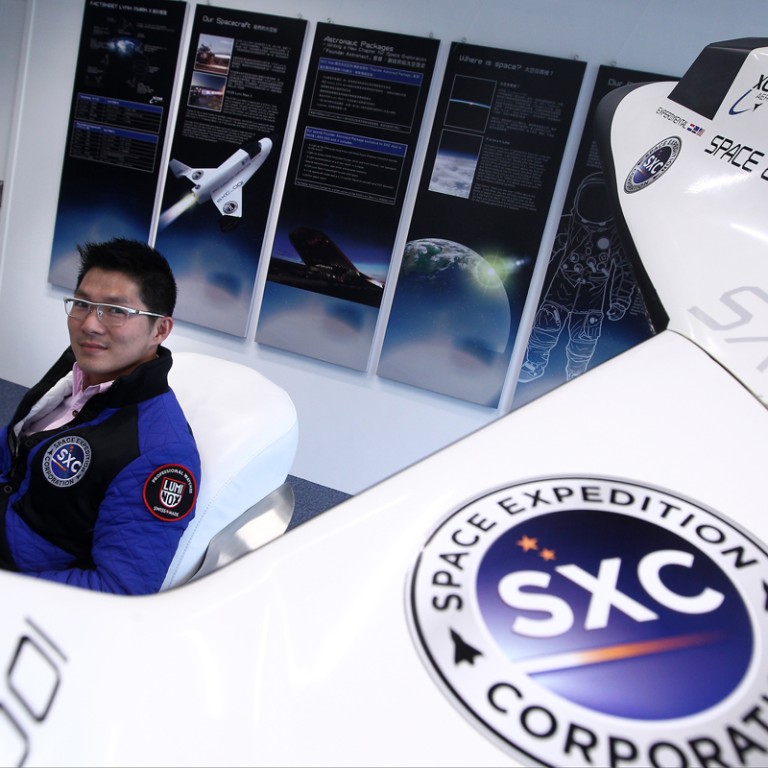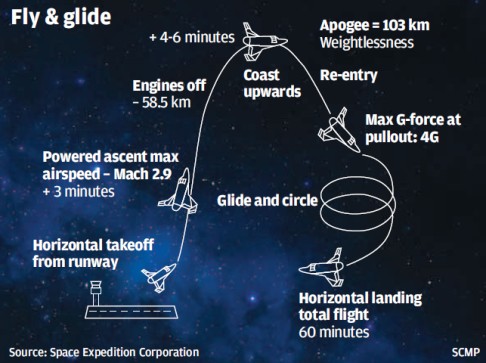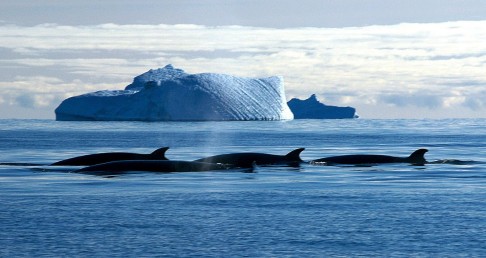
Out of this world
Two companies are set to give the first tourists a glimpse of outer space – the kind of adventure rich mainlanders crave, writes Denise Tsang
Please fasten your seat belt. The next destination is the edge of outer space.
Fly Me to the Moon won’t be just a song any more or part of science fiction after the first commercial space tour is scheduled to blast off later this year via Richard Branson’s Virgin Galactic. Another space tourism firm, Amsterdam-based Space Expedition Corp (SXC), will launch soon afterwards.
The cost of admission into the astronauts’ club is a minimum US$100,000 for a 60-minute space tour on SXC. Virgin Galactic’s 120-minute tour costs US$250,000.
Since Virgin Galactic was launched in 2005, about 600 people round the world have placed deposits for a space trip, the company said.
Both will let space tourists experience about five minutes of weightlessness in pitch-black daytime sky with a view of a curved earth under their feet.
The SXC flights will take off from either Mojave, California, or the Caribbean island of Curacao. It will take about four minutes to get to space, and the spacecraft will be travelling at three times the speed of sound up to about 100 kilometres above the earth, or the boundary to space called the Karman Line.
Then it will stay for about five minutes before returning to the base station.
Although a fat wallet is a necessity, that’s not enough, cautions Alex Tang, chief executive of SXC’s Asia-Pacific operations.
“Astronauts need to have passion and the guts to fly,” he said.
“It’s meaningless to fly with fear, which will kill off all the fun.”

A frequently asked question from aspiring astronauts is: “Will I be able to return home?” said Tang, who was in Beijing just before the Lunar New Year holiday, peddling SXC’s space tours. The ticket price was US$100,000 to US$220,000.
“Many have their concept of flying to the space from film, and fear that the spacecraft will run out of fuel and drift farther away from the earth and vanish into sheer darkness,” Tang said.
Launched in 2008, SXC is led by its two founders and managing partners, former Netherlands air force chief of staff Ben Droste and active Netherlands air force F-16 pilot Harry van Hulten.
In 2010, SXC commissioned XCOR Aerospace, a rocket producer in California, to build a spacecraft called Lynx. It’s designed to carry a pilot and a single passenger on a trajectory similar to that of the eight-seat SpaceShipTwo, built by Scaled Composites for Virgin Galactic, at the Mojave Air and Space Port.
But unlike SpaceShipTwo and its historic predecessor, SpaceShipOne – the first private manned vehicle to reach space – the Lynx will take off directly from a runway under its own rocket power, without needing a carrier aircraft to take it to high altitude before launch.
“Taking off from the ground is safer by far,” Tang said.
XCOR has fired about a dozen rocket engines since its founding in 1999, with no blow-ups yet.
Lynx will blast off with the help of four engines hoisting it 60 kilometres above sea level. The pilots will then switch off the rockets, but sheer momentum will keep the spacecraft shooting upwards, peaking at an altitude of 100 kilometres. Gravity will power the ship on its return to earth for a total flight time of 60 minutes.
SXC hired former Nasa astronaut Richard Searfoss as the chief pilot of Lynx. He judged a prestigious airspace competition, the Ansari X Prize, and awarded first place to SpaceShipOne after it reached an altitude of 100 kilometres twice in two weeks in 2004.
SpaceShipTwo, which had a successful test flight in September, is on track for commercial launch later this year. Branson has recently ordered four more SpaceShipTwos, which will operate from the new Spaceport America in the US state of New Mexico.
For SXC, more test flights are scheduled later this year. Space tourists won’t blast off until next year, at the earliest.
Globally, about 250 customers have been committed to the SXC tour by paying half of the cost. The company is still courting travellers from the mainland.
Two Hongkongers have already signed up. They are C-suite executives, a woman and a man, in their late 30s.
Tang said the pair, who are not related, have dreamt of travelling to space since childhood.
A third prospective Hong Kong customer, a senior executive, was forced to back out following objections from his wife.
“We realise the concern about safety. That’s why the two space travel companies, including us, will be setting industry standards for all future newcomers,” Tang said.
Aspiring mainland astronauts face a significant hurdle to signing to the Virgin Galactic programme: they need to hold a foreign passport or a United States green card to buy a ticket.
This is because of a cold-war-era rule known as International Traffic in Arms Regulations (ITAR), which forbids people from countries such as China, Iran and North Korea from having any access to US weapons technology.
Virgin Galactic’s spacecraft has a rocket, which is deemed military technology under those US rules.
A saleswoman at Miramar Travel, the sole agent in Hong Kong for Virgin Galactic, confirmed that those holding only a People’s Republic of China passport will not be allowed on the Virgin Galactic spacecraft.
“There is still some time [until take-off]. Some may be able to apply successfully for a green card or a foreign passport,” she said.
SXC has a launch site in Curacao, a Dutch colony, which means it is not subject to the ITAR ban on mainland passengers.
“We encourage [mainland clients] to pick Curacao, where they can enjoy sunshine, sandy beaches and shopping following the space tour,” said Tang.
Language is another issue. The Lynx spacecraft holds Searfoss, who speaks only English, and only one passenger at a time. Tang said an brief course in English is a necessary part of pre-flight training.
“Many of the tycoons found it too challenging to learn a foreign language, and counterproposed an offer of US$5,000 in tips to help pilot-astronauts learn some simple Putonghua,” Tang said. “It’s better to have one person to learn Putonghua than 100 people learning English.”
Mainland travellers are well known for their healthy appetites, which raises another issue: What’s the in-flight meal?
“I’ve been asked many times: ‘What do I eat in the cockpit?’,” said Tang, who said the query caught him off guard. “You can’t eat at all while wearing the pressure suit, I told them, and they were astonished.”
Space tourism is an expensive and niche class of travel. But it does speak to the wider trend for rich mainland tourists to seek ever more exotic destinations.
CLSA, a brokerage, published in January the results of a survey of 1,000 travellers in 41 mainland cities late last year. The findings shed some light on the growth prospects for this market.
With a cover showing an astronaut holding a five-star red flag floating in space, the 287-page report said the number of Chinese tourists going abroad is growing at “a pace that defies gravity”.
Departures, which hit a record of 100 million last year, is expected to double by 2020, it said.
It found that two-thirds of those polled said they would travel outside the country in the coming year. More than two-thirds said they would spend more money on travel.
Aaron Fischer, regional head of CLSA consumer and gaming research, attributed the growth to rising annual leave, an easing of visa rules, worsening pollution at home and an overloaded domestic tourism infrastructure.
“Explosive projected growth in outbound Greater China travel numbers offers immense opportunity for countries to benefit from Chinese tourists’ desire for new experiences – from sightseeing to food, to hotels, to gaming and shopping,” he said.
Hong Kong and Macau are the top domestic destinations, and for overseas, the US and France are hot.
Bart Tompkins – the China managing director of Amadeus, the world’s largest global distribution system for tour services – said most mainlanders favoured Europe or the US for holidays or shopping.
Still, he said, a small minority take off-the-beaten-track tours. He says he spotted some middle-class mainlanders in Yunnan province last year on a camping expedition.
He figures if well-heeled mainlanders can be persuaded to go camping, it’s plausible that a handful will make the leap into space, as well.
'WHERE NO ONE HAS GONE BEFORE'

Alex Zhang Yong and about 200 mainland tourists had their breath taken away in February when 20 whales circled their icebreaker while en route to the Antarctic.
The chartered tour spent 19 days flying round trip from Beijing to Argentina, and then by ship to Antarctica.
The tour is typical of those taken by more than 100 million mainland tourists who go abroad each year. But it was atypical in that their travels did not involve shopping stops at Harrods in London, the Galeries Lafayette in Paris, New York's Fifth Avenue or the Harbour City shopping mall in Kowloon.
"There was no shopping basically on the tour. We spent most of the time on the icebreaker we chartered," said Zhang, the chief executive of Dexo Travel and the leader of the once-a-year Antarctic expedition. "We saw more penguins and whales than people. The basic activity was taking pictures."
Beijing-based Dexo, which specialises in chartered tours to exotic destinations, caters to an emerging class of rich mainlanders looking for new experiences.
"Many of the people going on the tour are young entrepreneurs who just want an unforgettable journey, as they have a once-a-year chance for a long break," Zhang said. "They care a lot about where they go, and money is not an issue. They want to fulfil their dreams and have fame and glory."
Most travellers on the Antarctic tour were travelling in family units of three or four. An extreme case was a family of eight - a couple, children, parents and extended family. At 100,000 yuan (HK$127,000) a head, it's not cheap.
As the world's second largest economy, China is approaching the United States for the title of most billionaires, according to the Hurun Global Rich List.
As of January, there were 358 billionaires on the mainland, 41 per cent more than on last year's list.
Zhang said for tourists who can pay whatever the price, desired destinations include the poles (North and South) and even space. (See main story.)
Dexo's newest package is a 13-day tour via icebreaker starting from Beijing, passing through South Africa's Cape Town and then on to the Antarctic. It costs 500,000 yuan per head. It is, Zhang said, "arguably the most expensive [travel] offer … on the mainland".
For that price, travellers can expect a comfortable journey. There will be stopovers at five-star hotels. And the lingua franca of the vessel will be Putonghua, Shanghainese and Cantonese. No need to fumble around in English.
"The majority on the boat are Chinese mainly from Beijing, Shanghai and Guangzhou; only the crew is Western," Zhang said. "There is no need to speak in a foreign language at all."
Zhang, a 39-year-old native of Shandong province, was educated in Bali with master's degrees in economics and hospitality. He worked as a tour guide at the Louvre in Paris in 2000-05.
"I grew up in my father's study, in which there were books on geography, politics and nature," he said.
He has since returned to the mainland to work in the tourism trade, to cater to a more aspirational, imaginative class of traveller. He conducts tours to places that mainland travellers rarely see, such as recent sorties to the Alps and the Sahara Desert.
"The earth has run out of destinations for me," he said. "Space is my next destination."
He is not joking. Dexo is the sole agent on the mainland for space tour of Space Expedition Corporation, based in Amsterdam.

